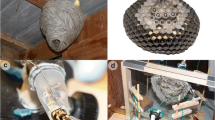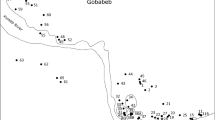Summary
The contribution to maternity of workers and female sexuals over time by queens in six multiple-queen laboratory colonies of Solenopsis invicta was directly assessed by use of enzyme genetic markers. Queens contributed more equally to the worker pool than to the pool of sexuals in virtually all samples (Fig. 1), and individuals producing a substantial proportion of the workers often had low or no representation of their daughters in the pool of sexuals. Signficant disparity among queens in their relative production of sexual daughters was often evident, with dominance in production of sexuals by a given queen commonly occurring in association with a pronounced loss of weight followed shortly by her death. The results suggest that significant variability in short-as well as long-term reproductive success may occur among the distantly related queens associating in natural polygyne S. invicta nests. Variance in apportionment of maternity of sexuals did not appear to be simply related to varying levels of fecundity, suggesting that the common presumption that reproductive success can be equated with fecundity in polygyne social Hymenoptera may not be well founded. The observed variance also did not appear to result from a simple mechanism of kin recognition and discrimination by workers in the process of brood rearing. Rather, this variance may have largely resulted from either, 1) recognition of certain queens and their progeny coupled with preferential sexualization of these immatures by nurse workers, or, 2) queen biasing of eggs toward development as sexuals. The frequent association of weight loss and death of mother queens with high levels of sexual daughter production may be best explained by the latter mechanism.
Similar content being viewed by others
References
Andersson M (1984) The evolution of eusociality. Ann Rev Ecol Syst 15:165–189
Banks WA, Lofgren CS, Jouvenaz DP, Stringer CE, Bishop PM, Williams DF, Wojcik DP, Glancey BM (1981) Techniques for collecting, rearing, and handling imported fire ants. USDA/SEA publication AAT-S-21, April
Bier K (1954) Über den Saisondimorphismus der Oogenese von Formica rufa rufo-pratensis minor Gössw. und dessen Bedeutung für die Kastendetermination. Biol Zentralbl 73:170–190
Brian MV (1983) Social insects; ecology and behavioural biology. Chapman & Hall, London
Brian MV, Hibble JV (1964) Studies of caste differentiation in Myrmica rubra L. 7. Caste bias, queen age and influence. Insectes Soc 11:223–238
Buschinger A (1968) Mono- und Polygynie bei Arten der Gattung Leptothorax Mayr. Insectes Soc 15:217–226
Buschinger A (1986) Evolution of social parasitism in ants. Trends Ecol Evol 1:155–160
Crozier RH (1977) Evolutionary genetics of the Hymenoptera. Annu Rev Entomol 22:263–288
Crozier RH (1979) Genetics of sociality. In: Hermann HR (ed) Social insects, vol I. Academic Press, New York pp 223–286
Crozier RH, Smith BH, Crozier YC (1987) Relatedness and population structure of the primitively eusocial bee Lasioglossum zephyrum (Hymenoptera:Halictidae) in Kansas. Evolution 41:902–910
Elmes GW (1972) Observations on the density of queens in natural colonies of Myrmica rubra L. J Anim Ecol 42:761–771
Evesham EJM (1984) Queen distribution movements and interactions in a semi-natural nest of the ant Myrmica rubra L. Insectes Soc 31:5–19
Fletcher DJC (1986) Triple action of queen pheromoes in the regulation of reproduction in fire ant (Solenopsis invicta) colonies. Adv Invert Reprod 4:305–316
Fletcher DJC, Blum MS (1983) Regulation of queen number by workers in colonies of social insects. Science 219:312–314
Fletcher DJC, Blum MS, Whitt TV, Temple N (1980) Monogyny and polygyny in the fire ant, Solenopsis invicta. Ann Entomol Soc Am 73:658–661
Fletcher DJC, Ross KG (1985) Regulation of reproduction in eusocial Hymenoptera. Annu Rev Entomol 30:319–343
Gadagkar R (1985) Evolution of insect sociality — a review of some attempts to test modern theories. Proc Indian Acad Sci (Anim Sci) 94:309–324
Gamboa GJ (1978) Intraspecific defense: advantage of social cooperation among paper wasp foundresses. Science 199:1463–1465
Gösswald K, Bier K (1954) Untersuchungen zur Kastendetermination in der Gattung Formica. 3. Die Kastendetermination von Formica rufa rufo-pratensis minor Gössw. Insectes Soc 1:229–246
Greenberg L, Fletcher DJC, Vinson SB (1985) Differences in worker size and mound distribution in monogynous and polygynous colonies of the fire ant, Solenopsis invicta Buren. J Kans Entomol Soc 58:9–18
Heinze J, Buschinger A (1987) Queen polymorphism in a nonparasitic Leptothorax species (Hymenoptera, Formicidae). Insectes Soc 34:28–43
Hölldobler B, Carlin NF (1985) Colony founding, queen dominance and oligogyny in the Australian meat ant Iridomyrmex purpureus. Behav Ecol Sociobiol 18:45–58
Hölldobler B, Wilson EO (1977) The number of queens: an important trait in ant evolution. Naturwissenschaften 64:8–15
Hölldobler B, Wilson EO (1983) Queen control in colonies of weaver ants (Hymenoptera: Formicidae). Ann Entomol Soc Am 76:235–238
Jeanne RL (1980) Evolution of social behavior in the Vespidae. Annu Rev Entomol 25:371–396
Jouvenaz DP, Allen GE, Banks WA, Wojcik DP (1977) A survey for pathogens of fire ants, Solenopsis spp in the southeastern United States. Fla Entomol 60:275–279
Keller L (1988) Evolutionary implications of polygyny in the Argntine ant, Iridomyrmex humilis (Mayr) (Hymenoptera Formicidae): an experimental study. Anim Behav 36:159–165
Knerer G (1983) The biology and social behaviour of Evylaeus linearis (Schenck) (Apoidea: Halictinae). Zool Anz 211:177–186
Lester LJ, Selander RK (1981) Genetic relatedness and the social organization of Polistes colonies. Am. Nat 117:147–166
Mercier B, Passera L, Suzzoni J-P (1985) Étude de la polygynie chez la fourmi Plagiolepis pygmaea Latr. (Hym. Formicidae) I. La fécondité des reines en condition expérimentale monogyne. Insectes Soc 32:335–348
Metcalf RA (1980) Sex ratios, parent-offspring conflict, and local competition for mates in the social wasps Polistes metricus and Polistes variatus. Am Nat 116:642–654
Metcalf RA, Whitt GS (1977) Intra-nest relatedness in the social wasp Polistes metricus, a genetic analysis. Behav Ecol Sociobiol 2:339–351
Michener CD (1964) Reproductive efficiency in relation to colony size in hymenopterous societies. Insectes Soc 11:317–341
Mirenda JT, Vinson SB (1981) Division of labour and specification of castes in the red imported fire ant Solenopsis invicta Buren. Anim Behav 29:410–420
Nonacs P (1988) Queen number in colonies of social Hymenoptera as a kin-selected adaptation. Evolution 42:566–580
Noonan KM (1981) Individual strategies of inclusive-fitnessmaximizing in Polistes fuscatus foundresses, In: Alexander RD, Tinkle DW (eds) Natural selection and social behavior. Chiron, New York pp 18–44
Noonan KC (1986) Recognition of queen larvae by worker honey bees (Apis mellifera). Ethology 73:295–306
O'Neal J, Markin GP (1975) Brood development of the various castes of the imported fire ant, Solenopsis invicta Buren (Hymenoptera: Formicidae). J Kans Entomol Soc 48:152–159
Page RE, Erickson EH (1984) Selective queen rearing by worker honey bees: kin or nestmate recognition. Ann Entomol Soc Am 77:578–580
Page RE, Erickson EH (1986) Kin recognition and virgin queen acceptance by worker honey bees (Apis mellifera L.). Anim Behav 34:1061–1069
Pamilo P (1982) Genetic population structure in polygynous Formica ants. Heredity 48:95–106
Pamilo P, Rosengren R (1984) Evolution of nesting strategies of ants: genetic evidence from different population types of Formica ants. Biol J Linn Soc 21:331–348
Pamilo P, Varvio-Aho S-L (1979) Genetic structure of nests in the ant Formica sanguinea. Behav Ecol Sociobiol 6:91–98
Pardi L (1948) Dominance order in Polistes wasps. Physiol Zool 21:1–13
Pearson B (1982) Relatedness of normal queens (macrogynes) in nests of the polynous ant Myrmica rubra Latreille. Evolution 36:107–112
Petersen-Braun M (1977) Untersuchungen zur sozialen Organisation der Pharaoameise Monomorium pharaonis (L.) (Hymenoptera, Formicidae). II. Die Kastendeterminierung. Insectes Soc 24:303–318
Plateaux L (1981) Difficulté du remplacement de la reine dans une colonie de la fourmi Leptothorax nylanderi. Ann Sci Nat Zool Paris 13:1–14
Ross KG (1988a) Reproductive and social structure in polygynous fire ant colonies. In: Breed MD Page RE (eds) The genetics of social insects. Westview, Boulder (in press)
Ross KG (1988b) Population and colony-level genetic studies of ants. In: Trager JC (ed) Advances in myrmecology. Brill, New York, pp 189–215
Ross KG, Fletcher DJC (1985a) Comparative study of genetic and social structure in two forms of the fire ant, Solenopsis invicta (Hymenoptera: Formicidae). Behav Ecol Sociobiol 17:349–356
Ross KG, Fletcher DJC (1985b) Genetic origin of male diploidy in the fire ant, Solenopsis invicta (Hymenoptera: Formicidae), and its evolutionary significance. Evolution 39:888–903
Ross KG, Fletcher DJC (1986) Diploid male production — a significant colony mortality factor in the fire ant, Solenopsis invicta. Behav Ecol Sociobiol 19:283–291
Ross KG, Vargo EL, Fletcher DJC (1987) Comparative biochemical genetics of three fire ant species in North America, with special reference to the two social forms of Solenopsis invicta (Hymenoptera:Formicidae). Evolution 41:979–990
Snedecor GW, Cochran WG (1980) Statistical methods (seventh edition). Iowa State University Press
Starr CK (1979) Origin and evolution of insect sociality: a review of modern theory. In: Hermann HR (ed) Social insects, vol I. Academic Press, New York, pp 35–79
Strassman JE (1981) Wasp reproduction and kin selection: reproductive competition and dominance hierarchies among Polistes annularis foundresses Fla Entomol 64:74–88
Sudd JH, Franks NR (1987) The behavioural ecology of ants. Blackie, Glasgow
Tschinkel WR, Howard DF (1983) Colony founding by pleometrosis in the fire ant, Solenopsis invicta. Behav Ecol Sociobiol 12:103–113
Vargo EL, Fletcher DJC (1986a) Queen number and the production of sexuals in the fire ant, Solenopsis invicta (Hymenoptera: Formicidae). Behav Ecol Sociobiol 19:41–47
Vargo EL, Fletcher DJC (1986b) Evidence of pheromonal queen control over the production of male and female sexuals in the fire ant, Solenopsis invicta. J Comp Physiol A 159:741–749
Vargo EL, Fletcher DJC (1988) On the relationship between queen number and fecundity in polygyne colonies of the fire ant, Solenopsis invicta. Physiol Entomol (in press)
Visscher PK (1986) Kinship discrimination in queen rearing by honey bees (Apis mellifera). Behav Ecol Sociobiol 18:453–460
Voss SH, McDonald JF Keith CH (1988) Production and abortive development of fire ant trophic eggs. In: Trager JC (ed) Advances in myrmecology. Brill, New York 517–527
Wade MJ (1985) The influence of multiple inseminations and multiple foundresses on social evolution. J Theor Biol 112:109–121
Ward PS (1983) Genetic relatedness and colony organization in a species complex of ponerine ants. I. Phenotypic and genotypic composition of colonies Behav Ecol Sociobiol 12:285–299
West-Eberhard MJ (1978) Temporary queens in Metapolybia wasps: nonreproductive helpers without altruism? Science 200:441–443
West-Eberhard MJ (1981) Intragroup selection and the evolution of insect societies. In: Alexander RD, Tinkle DW (eds) Natural selection and social behavior. Chiron, New York, pp 3–17
Wheeler DE (1986) Developmental and physiological determinants of caste in social hymenoptera: evolutionary implications. Am Nat 128:13–34
Wilson EO (1971) The insect societies. Belknap, Cambridge
Wilson EO (1974) Aversive behavior and competition within colonies of the ant Leptothorax curvispinosus. Ann Entomol Soc Am 67:777–780
Author information
Authors and Affiliations
Rights and permissions
About this article
Cite this article
Ross, K.G. Differential reproduction in multiple-queen colonies of the fire ant Solenopsis invicta (Hymenoptera: Formicidae). Behav Ecol Sociobiol 23, 341–355 (1988). https://doi.org/10.1007/BF00303708
Received:
Accepted:
Issue Date:
DOI: https://doi.org/10.1007/BF00303708




